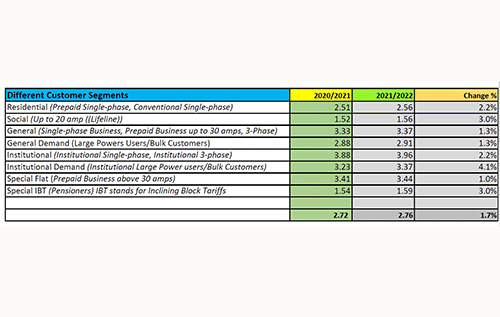The regional electricity distributor for Erongo has confirmed an average weighted tariff increase of 1.7% effective July 2021 to June 2022. This is after the Electricity Control Board (ECB) approved a weighted average of 1.7% tariff adjustment that resulted in increases on different customers segments. The price impact will vary depending on individual consumer consumption patterns.
Erongo RED’s CEO, Fessor Mbango, confirmed the increase on Tuesday, noting the distributor submitted an application to the ECB for the tariff increase for the 2021/2022 financial year. “It is worth noting that for the last two years, this will be the first time that Erongo RED is increasing the tariffs. For the last two years, Erongo RED did not increase any tariffs on the customers. As a company, we are still committed to providing subsidised tariffs especially now that Covid-19 has affected our vulnerable members of the community,” said Mbango.
The CEO added that with regard to statutory levies, the ECB levy will remain unchanged for the next 12 months, starting 1 July 2021 to 31 June 2022, while the mines and energy ministry has not pronounced themselves yet on the National Energy Fund Levy for the 2021/2022 financial year.
Mbango continued that despite an increase of about 3%, pensioners will continue to enjoy other benefits such as no basic charges up to 40-ampere circuit breakers and will also continue to enjoy subsidised tariffs (special tariffs) up to 40-ampere circuit breakers while installation of the prepaid box is free for them. Erongo RED also decided to continue with the free pre-paid meter project for pensioners and customers on debt management only.
“Erongo RED has resolved to continue with lifeline tariffs for customers on the 20- ampere circuit breakers. Customers on the 20 amperes will be charged on the
inclining block tariff structure. The inclining block tariffs mean that the electricity price is divided into three blocks. The first block of electricity is at the lowest price for the first 100 units. As the customer purchases more electricity during the month, the electricity bought will eventually fall in block 2 for the next 400 units, which is a bit more expensive. This process repeats automatically as the customer purchases further electricity to move into the last block, which is above
500 units.
At the end of each month, the history is reset and the customer will again start the next month from block 1. Thus, the first 500 units for this customer segment are subsidised,” Mbango explained.
Meanwhile, pre-paid customers above 20 Amp connections will continue on the flat tariff structure and customers in this category will be charged the same rate throughout the month.
Said Mbango: “As a good corporate citizen, we want to support vulnerable members of our community especially customers who cannot afford to pay the actual retail tariffs and we advise them to move to the lifeline tariff provided they meet the qualification criteria set out in the social tariff policy. Although it requires a behavioural change in how we use electricity, a person can comfortably manage with the 20 amperages with all basic household appliances connected. If consumers use electricity sparingly, then they will spend less on electricity but if people use the electricity carelessly then regrettably they will have to pay for the energy consumed.”
Erongo RED currently subsidises over 10 500 customers who consist of pensioners and lifeline customers, representing 24% of its active customer base.
Mbango stated that when Erongo RED makes a submission to ECB for a tariff adjustment, it always takes into account various factors such as the NamPower tariff adjustment, the consumer impact, community concerns, consumer liaison committee input, envisaged infrastructure development, as well as electrifications and operational cost.
“For this financial year, we also took into account the current economic situation and the impact of electricity cost on our commercial and industrial customers, the impact of Covid-19 on the industries, businesses, farmers and our residential consumers. We also took into account the fact that the company did not increase the tariffs in the last two years. Therefore, as a company, we have considered all possible ways to ensure that we pass on the least and reasonable tariff adjustments to the customers, whilst ensuring the sustainability of the company,” Mbango added, noting that Erongo RED had cut expenditure and put some projects on hold to accommodate customers.


